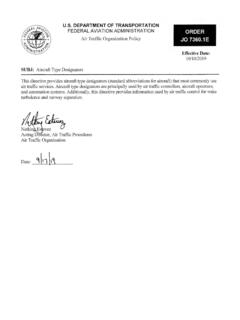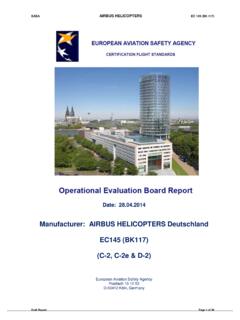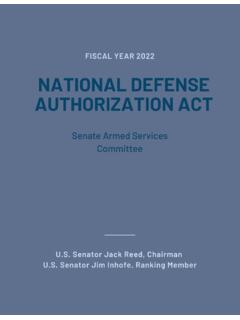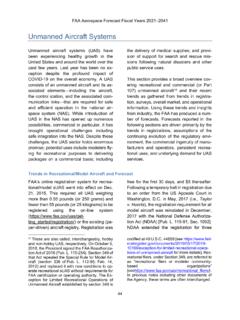Transcription of Assessment of C-Band Mobile Telecommunications ...
1 RTCA, Inc. 1150 18th Street, NW, Suite 910 Washington, DC 20036, USA Assessment of C-Band Mobile Telecommunications Interference Impact on Low Range Radar Altimeter Operations (RTCA Paper No. 274-20/PMC-2073) RTCA Prepared by: SC-239 October 7, 2020 2020 RTCA, Inc. Copies of this document may be obtained fr om: RTCA, Inc. 1150 18th St. NW, Suite 910 Washington, 20036, USA Telephone: 202-833-9339 Facsimile: 202-833-9434 Internet: Please call RTCA for price and ordering information. FOREWORD This document was prepared by Special Committee 239 (SC-239) and approved by the RTCA Program Management Committee (PMC) on October 7, 2020.
2 RTCA, Incorporated is a not-for-profit corporation formed to advance the art and science of aviation and aviation electronic systems for the benefit of the public. The organization develops consensus-based recommendations on contemporary aviation issues. RTCA s objectives include but are not limited to: coalescing aviation system user and provider technical requirements in a manner that helps government and industry meet their mutual objectives and responsibilities; analyzing and recommending solutions to the system technical issues that aviation faces as it continues to pursue increased safety, system capacity and efficiency; developing consensus on the application of pertinent technology to fulfill user and provider requirements, including development of minimum operational performance standards for electronic systems and equipment that support aviation.
3 And assisting in developing the appropriate technical material upon which positions for the International Civil Aviation Organization and the International Telecommunication Union and other appropriate international organizations can be based. The organization s recommendations are often used as the basis for government and private sector decisions as well as the foundation for many Federal Aviation Administration Technical Standard Orders and several advisory circulars. Since RTCA is not an official agency of the United States Government, its recommendations may not be regarded as statements of official government policy unless so enunciated by the government organization or agency having statutory jurisdiction over any matters to which the recommendations relate.
4 DISCLAIMER This publication is based on material submitted by various participants during the SC approval process. Neither the SC nor RTCA has made any determination whether these materials could be subject to valid claims of patent, copyright or other proprietary rights by third parties, and no representation or warranty, expressed or implied is made in this regard. Any use of or reliance on this document shall constitute an acceptance thereof as is and be subject to this disclaimer. This page intentionally left blank. i EXECUTIVE SUMMARY The Federal Communications Commission (FCC) has recently taken action to reallocate a portion of the GHz frequency band, making the frequency spectrum from GHz available for flexible use including 5G applications.
5 This spectrum will be auctioned to new licensees beginning in December 2020. The aviation industry noted in the FCC rulemaking process that deployment of 5G networks in this frequency band may introduce harmful radio frequency (RF) interference to radar altimeters currently operating in the globally-allocated GHz aeronautical band. Radar altimeters are deployed on tens of thousands of civil aircraft in the United States and worldwide to support several critical safety-of-life aircraft functions throughout multiple phases of flight. Radar altimeters are the only sensor onboard a civil aircraft which provides a direct measurement of the clearance height of the aircraft over the terrain or other obstacles, and failures of these sensors can therefore lead to incidents with catastrophic results resulting in multiple fatalities.
6 The aviation industry has explained to the FCC that further study was needed to adequately characterize the performance of currently fielded radar altimeters operating in the presence of RF interference from future 5G networks in the GHz band, as well as the risk of harmful interference and associated impacts to safe aviation operations, such that appropriate mitigations could be employed before such 5G networks begin operation. RTCA Special Committee 239 (SC-239) formed a 5G Task Force in April 2020 to lead this study effort as a multi-stakeholder group with open participation from the interested public. Using technical information supplied by the Mobile wireless industry and radar altimeter manufacturers, this report provides a quantitative evaluation of radar altimeter performance regarding RF interference from expected 5G emissions in the GHz band, as well as a detailed Assessment of the risk of such interference occurring and impacting aviation safety.
7 This process included testing of many representative radar altimeter models to empirically determine their tolerance to expected 5G interference signals; the development of interference models and assumptions to predict the received interference levels across a wide range of operational scenarios, such that they may be compared to the empirical tolerance limits; and a thorough study of multiple real-world operational scenarios for civil aircraft in which the presence of the expected 5G interference will result in a direct impact to aviation safety. The results presented in this report reveal a major risk that 5G Telecommunications systems in the GHz band will cause harmful interference to radar altimeters on all types of civil aircraft including commercial transport airplanes; business, regional, and general aviation airplanes; and both transport and general aviation helicopters.
8 The results of the study performed clearly indicate that this risk is widespread and has the potential for broad impacts to aviation operations in the United States, including the possibility of catastrophic failures leading to multiple fatalities, in the absence of appropriate mitigations. The extent of the RF interference is summarized by the worst-case exceedance of the safe interference limit of radar altimeters by expected 5G signals in the GHz band: 14 dB for commercial transport airplanes (as shown in Figure 10-4), 48 dB for business, regional, and general aviation airplanes (as shown in Figure 10-12), and 45 dB for helicopters (as shown in Figure 10-16). Further, the impacts are not only limited to the intentional emissions from 5G systems in the GHz band, but also the spurious emissions from such systems within the protected GHz radar altimeter band directly.
9 In this latter case, the worst-case exceedance of the safe interference limit is 28 dB for business, regional, and general aviation airplanes (as shown in Figure 10-25), and 12 dB for helicopters (as shown in Figure 10-29). Given the extent to which the safe interference limits are exceeded and the breadth of the impacts to aviation safety, the risk of harmful interference to radar altimeters cannot be adequately mitigated by the aviation industry acting alone. As such, it is envisioned that this report will be useful to those in the aviation industry, the Mobile wireless industry, and both aviation and spectrum regulators to understand and take appropriate steps in a timely fashion to mitigate this risk.
10 It is the responsibility of members of all of these groups to work together to ensure that safety-critical aviation systems will continue to be protected for the purposes of public safety. ii This page intentionally left blank. iii TABLE OF CONTENTS 1 INTRODUCTION .. 1 Radar Altimeters and Their Usage on Civil and Commercial Aircraft .. 1 Radar Altimeter Operational Requirements .. 1 Potential for RF Interference .. 2 2 BACKGROUND .. 3 Brief History .. 3 March 2020 FCC Report and Order .. 3 Multi-Stakeholder Industry Group .. 3 SC-239 5G Task Force .. 3 Technical Working Group 3 .. 4 3 SCOPE OF THIS RTCA ACTIVITY .. 5 Terms of Reference .. 5 Assessment Study Objectives.









